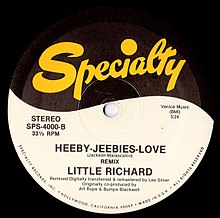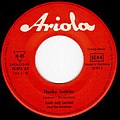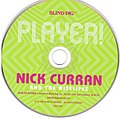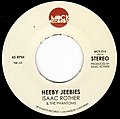Heeby Jeebies
| Heeby Jeebies | |
|---|---|
| Little Richard | |
| publication | October 1, 1956 |
| length | 2:10 |
| Genre (s) | Rock and roll |
| Author (s) |
John Marascalco Maybelle Jackson |
| Publisher (s) | Venice Music |
| Label | Specialty Records |
| album | Little Richard (album) |
Heeby-Jeebies is a rock 'n' roll - Song of Little Richard . Developed over several recording sessions from February to July 1956 for Specialty Records , the song was originally based on Little Richard's chart debut Tutti Frutti . After a few changes, the copyright was registered to the two songwriters Maybelle Jackson and John Marascalco . Heeby-Jeebies varies the structure of the 12-bar blues scheme and tells of the unrest that can affect lovers. The song was released several times on single , EP and LP in America, Europe and South Africa. Apart from a remix from 1981, Little Richard has not been reinterpreted since its official release, but the title was covered by Larry Williams in 1959 , by Kingsize Taylor in 1963 and by Australian Colin Cook in 1964 . In 1974 Heeby-Jeebies was part of a medley in the live repertoire of the blues rock band Cactus . From 1996 the neo-rockabilly scene took on the song and George Bedard & The Kingpins , the Boogiemen , Nick Curran , The Neatbeats and Mike Sanchez submitted recordings. Rock versions by the American band Isaac Rother & The Phantoms and the Swedish band Imperial State Electric followed in 2014 . None of the cover versions could follow Little Richards Original into the charts, where his single took seventh place on the American R&B list of the Billboard magazine in November 1956 .
Emergence
Since late 1955 Little Richard was under contract with the California record label Specialty Records. His debut single Tutti Frutti , recorded at Cosimo Matassa's J&M Studio in New Orleans , was a chart hit. For the recording of a follow-up single, the J&M studio was booked again on February 9, 1956 and, among other things, a first version of the title Heeby-Jeebies-Love was recorded. The singer and pianist was accompanied by the studio band with Edgar Blanchard on guitar, Frank Fields on bass, Lee Allen on tenor saxophone, Alvin Tyler on baritone saxophone and Earl Palmer on drums. All three takes were further developments by Tutti Frutti , whose intro and chorus melody was exactly adopted. The well-known scat shout "A-wop-bom-a-loo-mop-a-lomp-bom-bom!" Was slightly modified as "Wop-bop-a-leema-lama-wop-bobba-loo!" Use. The label boss Art Rupe selected Long Tall Sally as the next single from the February session and the recordings of Heeby-Jeebies-Love were archived.
The Mississippi- born songwriter John Marascalco heard Long Tall Sally on the radio and drove to Los Angeles in March 1956 to offer his two compositions Rip It Up and Ready Teddy Little Richards producer Bumps Blackwell . Both songs were first recorded on May 9, 1956 in New Orleans and together formed a double hit in the charts as Little Richard's third single. A week later on May 15th, Little Richard came back to the studio. Under the direction of Bumps Blackwell and Art Rupe, the singer recorded a revised version of Heeby-Jeebies with the studio band . Three complete takes of a slow version of the title have been preserved from this session , plus two attempts that were aborted shortly after the start. The Tutti-Frutti -Scat bond was replaced by the new hook line “Bad luck baby put a jinx on me”. John Marascalco and Maybelle Jackson are named as authors of Heeby-Jeebies in all publications . It is not known when the two songwriters were involved in the development of the song and to what extent.
Art Rupe and Bumps Blackwell were still not satisfied with the result of the May recordings and put Heeby-Jeebies back on the program at a recording session on July 30, 1956 . Again the song had been significantly revised: The previous chorus, which only repeated the song title “Heeby-Jeebies” several times, received a new text with the request “You gotta jump back, jump back…”, and the speed was increased significantly. Except for Roy Montrell , who took over the guitar this time, the same musicians played as on May 15th. After a test take, a version was found that met the requirements and was subsequently mastered by Art Rupe for publication on Little Richard's fourth specialty single . Little Richard remembered in 1984 in the authorized biography of Charles White a studio session in Los Angeles on September 6th, during which he played Heeby-Jeebies with his live band The Upsetters, among others . However, there is no corresponding evidence in the attached session graph.
Musical structure
The basic structure of the single version of Heeby-Jeebies is a twelve-bar blues , which can be heard in its pure form in the chorus and the saxophone solo. The functional chords can be represented with the level theory , whereby the first level corresponds to the tonic , the fourth level to the subdominant and the fifth level to the dominant :
- || I | I | I | I | IV | IV | I | I | V | IV | I | I ||
In the intro in the form of a first stanza , the first four bars of tonic are replaced by the hook line "Bad luck baby put the jinx on me" on two bars of tonic, which also ends the chorus on the last two bars.
- || I | I | IV | IV | I | I | V | IV | I | I ||
The second and third stanzas each consist of the first eight bars of the blues scheme, so they are shortened by the dominant, subdominant and tonic.
- || I | I | I | I | IV | IV | I | I ||
The sequence of the piece provides for a refrain and the second stanza after the intro. After another chorus and third verse, another chorus and the saxophone solo follow. Now verses two and three are repeated with a subsequent refrain.
content
Heeby-Jeebies is one of a long series of rhyming song titles from Little Richard's repertoire such as Tutti Frutti , Ready Teddy or Good Golly Miss Molly . The song is about the fears of a lover about the relationship with a girl. The unsafe situation gives him restlessness, goose bumps or discomfort (“Heeby-Jeebies”), which he attributes to a curse (“jinx”) of the unfortunate girl (“bad luck baby”). Critics primarily negotiate the song's hookline, which plays with occult images: “An unfortunate girl has cursed me” (“Bad luck baby put the jinx on me”). Dennis Drabelle thinks the text looks like a "hand edge", while David Kirby , alluding to the charm of the insecure relationship, suspects that the "curse" is not inconvenient for the protagonist. Little Richard's Specialty colleague Larry Williams was puzzled by the text while recording his version of the piece and judged the line “If I can't find my baby, then you know darn well, I'm gonna ring your door till I break your bell. ”from the first verse:“ The words don't make any sense! ”(“ Those words don't make no sense. ”)
publication
On September 17, 1956, the specialty publisher Venice Music registered the copyright to John Marascalco and Maybelle Jackson with the Library of Congress . The song was released on October 1, 1956 together with She's Got It on the single Specialty 584 in 7-inch and shellac format. Specialty Records did not assign a preferred A or B side to the songs of a single at that time, but left it to the market to decide which of the two sides of a record was in demand. In the same year the single was also released on vinyl and shellac under the number 1188 by the Belgian record company Ronnex , in Canada Regency Records was responsible for the distribution of the record. Only three years later, in November 1959, the Dutch Artone Records followed with Artone 24034 and the following year again with Artone 24149. Specialty also had a branch in the Netherlands and published Specialty 25.264 in 1965. The year of issue of the South African shellac version on London Records is unknown. A British edition of the song only took place in the 1970s on the British Specialty under the number 5015, on which Heeby-Jeebies was coupled with Long Tall Sally .
The EP was released in the United States in 1958, when Little Richard Vol. 3 combined the title with Boo Hoo Hoo Hoo , The Girl Can't Help It and Send Me Some Lovin ' as Specialty EP-405. An EP conceived in Great Britain by London Records entitled Little Richard and his Band and the number 1071 was released in the UK in 1957 and from 1958 in Germany, France, Italy and Norway, South Africa and Sweden. Another EP release in Germany and the Netherlands at London 3051 was Great Hits with Little Richard . From a French EP on London 10012 no title is known. A London edition published in Sweden in 1959 with the number 5041 was simply titled Little Richard , which was followed by an EP edition on green vinyl on the Swedish Sonet 6071 in 1964 .
Heeby-Jeebies first appeared regularly on LP on Little Richard's second specialty album Little Richard in December 1958. This was followed in 1968 by the American compilation Little Richard's Grooviest 17 Original Hits on Specialty 2113, and in 1976 the British edition Specialty SNTF 5017 under the title of 20 Original Greatest Hits and the following year 22 original hits on Warwick Records WW 5034. A Danish picture disc called Little Richard under the number AR-30012 contained the song as well as GRT 2103-725 with the title The Original Little Richard Recordings . In 1980 Heeby-Jeebies was featured in the German specialty edition Star Portrait . All received versions were officially released in 1989 on the 6-CD box The Specialty Sessions from Ace Records .
When disco music was popular, Specialty had several songs revised by Little Richards. Lee Silver remixed the early song version Heeby-Jebbies-Love , which was released in 1981 together with Lucille (remix) on a 12-inch maxi single for 33 revolutions per minute. This publication was commercially unsuccessful. The underlying track Heeby-Jeebies-Love came out in 1983 on Specialty single SP-736 together with All Around the World . Two more years later, the maxi single with the remix was re-released as Specialty 741 in 7-inch format.
Cover versions
| Cover versions |
|---|
|
Little Richards Specialty colleague Larry Williams played the first cover version of Heeby-Jeebies on February 19, 1958. He was accompanied as a band by Gerald Wilson on trumpet, Plas Johnson on tenor saxophone , Alvin Tyler on baritone saxophone , Earl Palmer on drums, Ernie Freeman on piano and Barney Kessel on guitar. A solo whistled by Williams replaced the saxophone. The recording was withheld and only appeared in 1973 on the album The Great Rock Stars by the Dutch bootleg label Redita under the number RLP-103. In 1987 an alternative take was released on the album Alakazam! at Ace Records including a puzzled comment about the obscure text to the studio director. The first published cover was a live recording of the Liverpool band Kingsize Taylor & the Dominoes from the Hamburg Star Club in 1963. It was released in 1963 on the LP King Size Taylor and the Dominoes Live in the Star Club Hamburg Volume 2 with Ariola as well on single under the number Ariola 18074. The company also combined the rock 'n' roll concert with an appearance by Bobby Patrick Big Six as a split double LP. In 1964 the Australian performer Colin Cook followed with his version on the label W&G under the number WG-S-2324.
The American blues rock formation Cactus took Heeby-Jeebies into their live repertoire in the 1970s and played the piece as part of a rock 'n' roll medley that was recorded at two concerts and was released years later on Rhino Records . The 2004 LP Fully Unleashed: The Live Gigs contained the 17-minute medley of Heeby-Jeebies , Money (That's What I Want) , Hound Dog and What'd I Say . In 2007 the Cactus album Fully Unleashed: The Live Gigs Vol. 2, recorded by Eddie Kramer , followed with a two-hour concert on June 26, 1971 in Buffalo, in which Heeby-Jeebies only combined What'd I Say in a 12-minute performance has been. After the singer of the band Rusty Day was fired, he hired to replace Mitch Ryder in his band The Detroit Wheels, which was reorganized under the name "Detroit". In 1973 there was an unofficial live recording, which has only been circulated as a Lynyrd Skynyrd bootleg since 1998 due to the participation of the later Lynyrd Skynyrd singer Steve Gaines . This record called The Driftwood Tapes features a medley of Long Tall Sally , Heeby-Jeebies and She's Got It .
From the mid-1990s, the neo-rockabilly scene discovered the "classic". George Bedard & The Kingpins recorded the title in 1996 for their second album Hip Deep on Schoolkids' Records. Kevin Ransom thinks that Bedard is adapting the hiccups style of the young Elvis Presley known from rockabilly and giving the recording the atmosphere of a groundbreaking Sun Records session . Also in 1997, the blues band Boogiemen released the song for the Blue Loon label on their Boogie Time album , which was nominated as a blues album for the Minnesota Music Award. In 2004 Nick Curran and the Nitelifes followed with the album Player! on Blind Pig Records. The Japanese band The Neatbeats finally recorded Heeby-Jeebies in 2006 for their live DVD Neatle Mania and in 2008 for their album Roll on Good on BMG Japan. The British musician Mike Sanchez released the song in 2008 on his album You Better Dig It on Doopin 002. It played alongside Sanchez on piano and microphone, Mark Morgan on drums, Al Gare on bass, Oliver Darling on guitar and Nick Lunt and Paul Corry the saxophones.
At Christmas 2014, the Swedish rock band Imperial State Electric, led by singer and guitarist Nicke Andersson, released a vinyl single limited to 500 copies on the Japanese label AM Records . Behind the A-side with (Why Don't You) Leave It Alone is Heeby Jeebies as the B-side . The British music portal Über Röck thinks the single contains "two classics that have been covered in a tasteful manner". In September 2014 the band Isaac Rother & The Phantoms recorded the piece in El Segundo , California. Issac Rother and Matthew Zuk played on guitars, Mikki Itzigsohn on bass, Alberto Mendoza on drums and Steven Moos on keyboards. Michelle Rose and Veronica Bianqui support the singer Rother in the background. A single was released in early 2015 on the Los Angeles label Mock Records together with the title One Ain't Enough .
Importance, Criticism, and Success
Specialty 584 with Heeby-Jeebies and She's Got It was Little Richard's fourth hit single in a row since making his Specialty Records debut with Tutti Frutti in November of the previous year . However, it was his first specialty record, which was only placed in the black rhythm and blues charts and which failed to crossover into the general pop market. Of the 20 songs that Little Richard had recorded for the label before his temporary retirement in 1957 and that scored in the American or British charts, Heeby-Jeebies was the only one that he did not record again on various comebacks in the course of his career. The number of Heeby-Jeebies cover versions also lagged significantly behind that of his greatest hits.
As early as October 8, 1956, Billboard Magazine had reviewed the single and stated: “Richard, in his shouting style, smashes two strong numbers with a fat beat and exciting accompaniment and thus uses the same formula that made him to the top of the charts with previous releases catapulted. Heeby-Jeebies is a driving number with a fast-paced, fiery text that increases to ecstasy. The back with clever lyrics has a similarly powerful effect. "
|
Chart positions Explanation of the data |
||||||||||||
| Singles | ||||||||||||
|
||||||||||||
The Billboard R&B charts passed in 1956 with the sales charts (“R&B Best Sellers in Store”), the jukebox charts (“Most Played R&B in Juke Boxes”) and the radio charts (“Most Played R&B by Jockeys”) three separate leaderboards. In the case of the first two, the single was rated primarily by its main title, only the radio charts led both sides of the record separately. Specialty Records deliberately refrained from being assigned to the A and B sides and left it to the market to decide which title was preferred. Specialty 584 shows the unusual effect that with She's Got It one side of the record was placed in the sales charts and the other side with Heeby-Jeebies in the juke box charts. The latter made its debut on November 3, 1956 at number ninth, had disappeared from the ten-digit list at the time in the following three weeks and celebrated re-entry at number ten on December 1. With seventh place, Heeby-Jeebies was highest on December 8th and placed for the last time. In the sales charts on November 10, 1956, the title was only mentioned in the sense of a B-side to She's Got It that was part of the success of the record . In contrast to the other side of the single , Heeby-Jeebies was completely absent from the radio charts . According to Joel Whitburn's method of chart statistics, Heeby-Jeebies spent three weeks in the R&B charts and occupied seventh place as the highest position. Heeby-Jeebies reached a 50th place in the pop charts of the Cashbox magazine , which compete with the Billboard, and clearly stood out from the unplaced back She's Got It . None of the cover versions made it into the charts.
Only a few critics were explicit about Heeby-Jeebies and praised the high-energy performance . Little Richard biographer Paul MacPhail described both sides of the record as "wildly pounding rock 'n' rollers". Larry Birnbaum's analysis hears a "frenzied" recording and highlights Lee Allen's saxophone solo over Little Richard's percussive piano playing of the eighth notes. Otis Redding , who, like Little Richard, came from Macon , Georgia and was oriented towards the rock 'n' roll star as a teenager, reports on the successful use of the title in local talent competitions: “This song inspired me to start singing. For fifteen consecutive evenings I won the talent competition with this song, and then they wouldn't let me sing anymore, they wouldn't let me win the five dollars. "
Web links
- Heeby-Jeebies-Love (Take 1, 2 and 3) with Tutti-Frutti call from February 9, 1956
- Slow version (Take 5) from May 15, 1956
- Slow versions from May 15, 1956 (Take 6, 7 and 8)
- The alternative take (Take 5001) from July 30, 1956
- The officially published version (master) of July 30, 1956
Individual evidence
- ↑ a b c Ray Topping: Little Richard. The Specialty Sessions . ACE Specialty, 1992 (English, liner notes, 6 CD set).
- ↑ a b Larry Birnbaum: Before Elvis. The Prehistory of Rock 'n' Roll . 1st edition. Scarecrow Press, Lanham, Toronto, Plymouth 2013, ISBN 978-0-8108-8638-4 , Good Rockin 'Tonight, pp. 336 f .
- ↑ a b c d Valeri Orlov: Little Richard. All rock 'n' roll and blues rock studio recordings. In: Little Richard. The Quasar of Rock. Retrieved March 16, 2014 .
- ^ Charles White: The Life And Times Of Little Richard. The Authorized Biography . Omnibus Press, London / New York / Paris / Sydney / Copenhagen / Berlin / Madrid / Tokyo 2003, ISBN 0-7119-9761-6 , Tutti Frutti, p. 74 (first edition: 1984).
- ↑ Bob Leszczak: Who Did It First ?: Great rhythm and blues cover songs and Their original artists . Scarecrow Press, Lanham 2013, ISBN 978-0-8108-8866-1 , Ready Teddy, pp. 175 (American English).
- ↑ Dennis Drabelle: Book review: Jerry Lee Lewis by Joe Bonomo and Little Richard by David Kirby. In: Washingtonpost.com. December 6, 2009, accessed March 16, 2014 .
- ↑ David Kirby: The Mastersinger of Macon . In: Susan Hahn (Ed.): TriQuarterly 130 . Northwestern University Press, Evanston 2008, ISBN 978-0-8101-5929-7 , pp. 9-17 (American English).
- ↑ a b Ray Topping: Alacazam! Ace Records, 1987 (American English, liner notes).
- ^ Public Catalog. In: Library of Congress. Retrieved March 15, 2014 .
- ↑ a b c John Garodkin: Little Richard Special . 2nd Edition. Mjoelner Edition, Praestoe 1984, ISBN 87-87721-14-7 , Specialty Records, pp. 23-66 .
- ↑ David Edwards, Mike Callahan, Randy Watts: Specialty Album Discography, Part 2: SP-5000, SPS-4000, SPCD-7000, and SPCD-7200 Series. In: BothSidesNow. Retrieved March 20, 2014 .
- ↑ Little Walter: Larry Williams , Liner Notes on Specialty LP-2162, Specialty Records 1986
- ↑ Donald Clarke (Ed.): The Penguin Encyclopedia of Popular Music . 2nd Edition. Penguin, London, New York 1998, ISBN 0-14-051370-1 , pp. 1383 .
- ↑ Lindsay Planner: Fully Unleashed: The Live Gigs. In: Allmusic. Retrieved April 8, 2014 .
- ↑ Hal Horowitz: Fully Unleashed: The Live Gigs, Vol. 2. In: Allmusic. Retrieved April 8, 2014 .
- ↑ a b Chris Morris: Declaration of Independents . In: The Billboard . April 26, 1997 (English).
- ↑ Kevin Ransom: Hip Deep - George Bedard and the Kingpins. In: George Bedard. Archived from the original on February 11, 2015 ; accessed on April 8, 2014 .
- ↑ Ray Stiles: Boogiemen. In: Blues on Stage. Retrieved April 8, 2014 .
- ↑ Matt Collar: Player! In: Allmusic. Retrieved April 8, 2014 .
- ↑ Discography. In: The Neatbeats. Retrieved April 20, 2014 .
- ↑ Mike Sanchez. Discography. Retrieved August 18, 2014 .
- ↑ (Why Don't You) Leave It Alone / Heeby Jeebies. In: AM Records. Retrieved January 21, 2015 .
- ↑ New Imperial State Electric 7 "vinyl available to pre-order. October 22, 2014, accessed January 21, 2015 (English).
- ^ Isaac Rother & The Phantoms: Heeby Jeebies . Mock Records, 2015.
- ↑ a b c d e Joel Whitburn: Hot R&B Songs. Billboard 1942-2010 . 6th edition. Record Research Inc., Menomonee Falls 2010, ISBN 978-0-89820-186-4 , The Artist Section, pp. 401 (American English).
- ↑ John Garodkin: Little Richard Special . 2nd Edition. Mjoelner Edition, Praestoe 1984, ISBN 87-87721-14-7 , Title Index with Composers, pp. 217-225 .
- ↑ Review Spotlight On… In: The Billboard . October 6, 1956, p. 84 .
- ^ A b Paul MacPhail: Little Richard: The Originator of Rock . Self-published, 2008, p. 16 .
- ^ Peter Guralnick: Sweet Soul Music . Bosworth Music GmbH, Berlin 2009, ISBN 978-3-86543-321-3 , Otis Redding, p. 166 f . (English, original title: Sweet Soul Music . Translated by Harriet Fricke).










